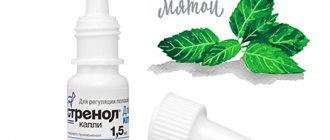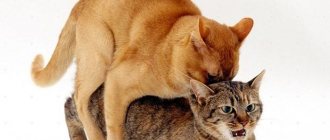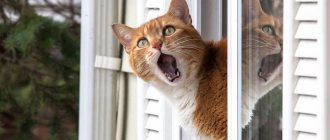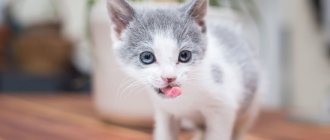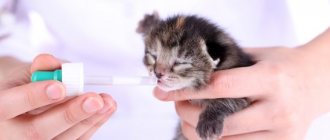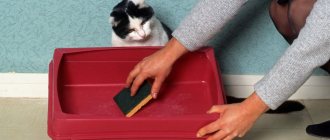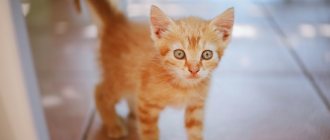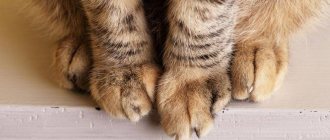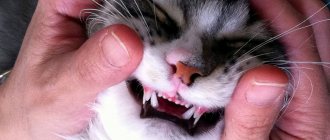26.05.2020
The mother cat closely monitors the toilet of a newborn kitten, carefully licking it and keeping it clean. With the arrival of a small kitten in the house, the responsibility for monitoring the proper functioning of its digestive system falls on the owner.
How often kittens go to the litter box determines their future health. To help the pet develop healthy, it is useful for the owner to know why bowel problems occur, how many times month-old kittens should go to the toilet, and what to do if the kitten does not go to the toilet for a long time.
Tray for newborn kittens
A mother cat helps a newborn kitten go to the toilet in the first three weeks of its life. A cat, licking its cubs, not only cleanses them of dirt and foreign odors, but also stimulates blood circulation in the digestive organs.
Thanks to this massage, it is easier for the kitten to get rid of gases and empty itself. The cat licks off all the dirt, leaving the appearance that the kitten does not go to the toilet at all.
"Attention! In order for the kitten to get into the tray without problems, it is important that the kitten tray has low sides.”
If for some reason the cat does not know how to provide proper care to the kitten, you can help him yourself. In a situation where the kitten does not want to go to bed for several days, and in order to eliminate the consequences of a bloated abdomen from gases, certain actions need to be taken.
Using a soft brush or cotton wool moistened with warm water, gently massage the kitten's belly in a clockwise direction in a circular motion. Additionally, a soft massage is performed in the direction from head to tail, with longitudinal movements.
Expert advice
By following these simple tips, you can reduce the risk of something unwanted happening to your baby.
- If you plan to have a kitten in the house, which will continue to live and be raised in your family, take care of its safety in advance. There is no need to put off cleaning up dangerous objects until the baby stands on its paws. This may happen sooner.
- Secure your cat's bed by finding a secluded corner for it. Otherwise, a mother cat can take her babies by the scruff of the neck and take them to a safer place, in her opinion, which in reality may turn out to be completely unsuitable.
- If the baby does get into trouble and injures its paw, it is better to call a veterinarian at home, and keep the baby in a stationary position until the doctor arrives. Transporting a kitten with an injured limb can make matters worse.
- If there are no carpets at home, the kitten will slide, and this can lead to dislocation of weak legs. Temporarily lay down rugs so that the baby does not get entangled in the pile and travels normally in his own little world.
Being in a human home, a mother cat is not always able to protect her baby from troubles, especially during periods of active running around. A wise owner should help his pets maintain their paws and health.
Tray for one-month-old kittens
Upon reaching three weeks of age, the kitten’s intestines are already sufficiently populated with beneficial microflora, formed and ready to accept adult food. At this age, the kitten still feeds on mother’s milk with gradual complementary feeding in the form of liquid kitten food or creamy food. This food does not injure the intestines and does not require too thorough chewing.
At three weeks of age, a kitten should go to the toilet approximately 3 to 6 times daily. Normally, a kitten's feces should be mushy, uniform and thick. They should not contain impurities in the form of mucus or undigested food elements. The kitten itself should be cheerful, and its belly should be soft to the touch and painless. An unfavorable sign for the owner is kitten feces that are too dry or too runny.
If the kitten does not have stool for 3 or 4 days, you need to carefully analyze the pet’s diet. Abdominal massage, microenemas, and a small amount of vegetable oil can help.
Features of defecation
At three weeks of age, it is time for animals to try new foods. In nature, at this time, acquaintance with prey occurs, some of which the mother brings to the den and gives to the kittens to try or regurgitates the remains of food. Everything is justified: the stomachs of babies are not adapted to digesting solid pieces, and the transition to such food is carried out smoothly.
Pets are offered their first complementary foods: homogeneous liquid and semi-liquid food. Only in this way will the stomach be able to cope with its work, and the digestion process will be streamlined. Gradually other, more solid foods are offered. The kittens will continue to suckle their mother for a long time, but they no longer need her to cope with their natural needs.
As soon as small cats begin to eat themselves, the anogenital reflex is finally developed.
At the age of just over a month, kittens walk small and large on their own, and it’s time to train them to use the toilet.
Toilet for adult kittens
The kitten is transferred to adult food from the age of 1 to 3 months. In general, coca feces become more shaped. The number of visits to the toilet, as well as the consistency of feces, depend on the type of food the kitten eats. When eating food with a lot of fiber, the number of bowel movements will be greater than with high-protein food.
A grown kitten goes to the toilet almost every day, and its feces should be free of blood, mucus, and undigested food. The owner should be wary of the fact that the pet often goes to the toilet with very liquid feces.
In what cases should you consult a veterinarian?
Sometimes in kittens the development of bowel and bladder emptying is accompanied by disturbances. Deviations from the norm can be a symptom of serious problems with the internal organs of a small four-legged pet. You can recognize them in time by:
- constant monitoring of the baby’s behavior during defecation and urination;
- assessing the consistency, color and odor of urine and excrement;
- analysis of the frequency of bladder and bowel movements.
If there are alarming signs, you should take your baby to the vet as soon as possible. It may not reveal any abnormalities in the four-legged patient, but it is better to play it safe, since it is difficult for kittens’ fragile bodies to deal with even minor problems. A veterinarian’s consultation is required for your pet in the following cases:
- Abnormal consistency of feces. They should not be too liquid or dry. Loose stools are only allowed in kittens that are fed only breast milk. In older animals, excrement is normally formed and quite dense. They can liquefy if the pet has eaten something wrong, and return to normal the next day. If this does not happen, it is recommended to show the baby to the veterinarian as soon as possible.
- The presence of foreign matter in feces and urine. Blood, mucus, pus in a kitten's excrement and urine can be a sign of serious pathological processes in its body. There should be no partially digested food in the feces and sand in the urine either. Cloudy urine is a bad sign.
- Changing the behavior of a small four-legged pet. Normally, healthy kittens are energetic and cheerful. They happily eat the dishes offered to them, drink water, sleep soundly, and readily take part in outdoor games. If the animal has become lethargic, apathetic, lies most of the time, sleeps poorly, and does not respond to external stimuli, this is a reason to immediately show it to a veterinarian.
- Firm, enlarged tummy. Normally, in kittens it is soft, without signs of excessive accumulation of gases in the intestines. They should not experience discomfort when feeling it.
- Frequent or, on the contrary, rare bowel and bladder emptying. The pet must visit the litter box daily. If he does not do this every day or the frequency of urination and bowel movements deviates significantly from the daily norm, you need to urgently find out the cause of this phenomenon.
- Difficulty in emptying. If a small pet cannot urinate, often comes to the tray, sits down for a long time and meows pitifully, you should immediately show it to the veterinarian.
- Excretion of urine and feces in small portions. The kitten should have complete bowel and bladder emptying.
- Increased body temperature.
- Partial or complete loss of interest in food.
- Attacks of nausea and vomiting.
- Pale gums.
- Hot nose and ears.
- Loss of body weight.
Source
How often should a kitten pee?
When answering the question of how often a kitten should pee, you need to take into account the amount of liquid it consumes. The amount of urine should be equal to the volume of liquid drunk. A very small kitten has a small bladder capacity and will pee more frequently than an adult.
On average, a kitten goes to the toilet up to 10 times a day. An older kitten will have to go to the toilet up to 5 times a day. An adult cat goes small no more than 3-4 times a day.
"Attention! If your pet's diet is high in fiber, the number of trips to the toilet may increase."
The process of urination itself is normal and should not cause discomfort to the kitten. It is worth paying attention to the quality and color of urine, its transparency, the presence of impurities in the form of blood and mucus.
2. Reasons
Possible causes of rare urination are quite numerous, and they are usually divided into three large groups: prerenal, renal and postrenal (from the Latin “ren” - kidney).
Thus, prerenal causes may include situational factors: profuse sweating during heavy physical exertion (if the amount of water drunk is insufficient), intense vomiting, diarrhea, blood loss. The normal process of urine formation can be inhibited or blocked by strong alcoholic drinks (beer is known to exhaust the kidneys with increased urine production), long-term use of certain medications, and kidney injury.
Actually renal (renal) causes include, first of all, inflammatory processes from the group of nephritis (pyelonephritis, glomerulonephritis, mixed forms); difficulties with blood circulation (for example, blockage of the renal arteries or veins with atherosclerotic plaques, blood clots, etc.), as well as chronic renal failure of other origins.
Finally, postrenal causes usually imply a mechanical obstruction in the underlying urinary tract - the ureters, bladder and urethra - most often stones, tumors, various types of stenosis or strictures (narrowing of the lumen). In men, a common cause of decreased urination is prostatitis.
The conduction and processing of nerve signals (urges) about the need to empty the bladder can be disrupted due to injury or other pathology of the central nervous system - the brain and especially the spinal cord.
Why does a kitten have problems with stool?
Stress has affected bowel function. A kitten may refuse to go to the toilet due to worries about moving to a new home, changing its owner, or being separated from its mother. To help the kitten get comfortable in a new place, you should protect it from noise, sudden movements, and games with children. The kitten itself must begin to play in the new territory, run, and go to the toilet. If the kitten does not defecate within 5 days, you should contact a veterinarian.
Due to poor nutrition, the functioning of the digestive system is disrupted. In a new home, the kitten must adhere to the diet of its old owners for some time, with a gradual addition of new cat food. When choosing ready-made food, you should pay attention to special diets for kittens.
If a kitten does not walk for more than 5 days, even having gotten used to a new place and food, then constipation may be the cause of problems with stool. By feeling your pet's abdomen, you can determine the presence of bloating, which usually accompanies constipation.
A sign of constipation is the painful process of defecation in your pet. Signs of constipation are also: sitting on the tray for a long time, plaintive meowing.
How to deal with constipation in a kitten yourself
If your pet feels well enough, you can try to cope with your kitten’s constipation yourself with the help of:
- Oils: if the kitten does not go to the toilet for several days, you can give simple vegetable oil in an amount of no more than half a teaspoon per day. You can introduce it into the mouth using an ordinary syringe without a needle, slowly so that the kitten does not choke. Vaseline oil is also effective for constipation. It can be added at each feeding, 0.5 ml, in combination with a gentle therapeutic massage.
- Soap: you need to make a small peg of baby soap and insert it into the anus. Before administration, the soap should be moistened in warm water. It is more convenient to carry out this action while the pet is sleeping. After it, within a few hours, the kitten should successfully go to the toilet for the most part.
- Medications: You should consult your veterinarian about the appropriateness and correct use of medications.
- Enema: the enema procedure at home is carried out only in full confidence that it is harmless to the kitten. This procedure is relatively safe only if the cause of constipation is precisely inappropriate nutrition, and not intestinal obstruction or volvulus. There is a list of conditions for which an enema is strictly contraindicated: inflammatory processes in the intestines, bleeding, rectal prolapse, acute pathologies of the abdominal organs, inflammatory processes in the intestines.
Do-it-yourself enema of a kitten
To do an enema yourself, you will need a 10-milligram syringe, warm boiled water, Vaseline or oil. It is advisable to do the procedure with an assistant: one will hold the kitten, and the second will slowly insert a syringe pre-lubricated (with Vaseline or oil), deep enough so that the liquid is distributed as intended.
During the procedure, you need to slowly introduce water, gently palpating the pet's stomach to ensure that the intestines are sufficiently full. For a kitten, 50-100 ml of water is enough for the procedure.
General information about the kitten's toilet
A kitten can go to the litter box from 10 times a day (in the early stages) to 5 times a day when growing up. If the kitten goes to the toilet too infrequently (up to 4 times a day), or goes to the toilet too often, or has other warning signs (blood, mucus in the urine), the owner should immediately contact a veterinarian.
On average, one-month-old kittens poop on their own 3 to 6 times a day. A kitten in a new place often does not go to the toilet for up to 5 days. If, after adaptation to the new place, the situation does not change, measures need to be taken.
The answer to the question of how often to change the tray depends on the composition of the litter. In general, after each visit to the litter box by a kitten, there should be no traces or smell left in it, otherwise the kitten will try to find another secluded place to relieve itself.
Preventing constipation and diarrhea
You've already learned how often kittens poop and how to care for them. A loving owner should also take care of preventing problems with bowel movements. To do this you need:
- comb the animal regularly so that excess hair does not clog the intestines when licking;
- give kittens phytomines to cleanse the intestines;
- feed your pet a variety of foods, using foods rich in fiber;
- give space for your pet’s active life, which improves intestinal motility;
- contact your veterinarian in time.

